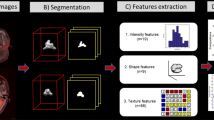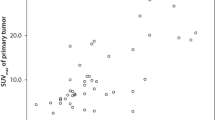Abstract
This study was to investigate a better way to detect and differentiate primary, residual, recurrent nasopharyngeal carcinoma (NPC) lesions post-radiotherapy in patients with NPC by means of routine computed tomography (CT) in combination with 99Tcm-sestamibi single photon emission computed tomography (99Tcm-MIBI SPECT). Forty-eight patients with histologically confirmed primary NPC underwent 99Tcm-MIBI SPECT at the 3rd month before and after radiotherapy, and at the 6th month after radiotherapy. All patients had contemporaneous CT examinations. Histopathologic results and/or clinical follow-up data (over 18 months) were used as the golden standard for evaluating residual/recurrent lesions. The radioactive count ratio of nasopharynx to scalp was obtained as the MIBI uptake index (MUI). Receiver operating characteristic analysis was employed to define the cut-off value of MUI for malignancy.With MUI 2.15 as the cut-off point, the accuracy for detecting primary NPC was 94.12%. The mean MUI in the local-regional of the nasopharynx in such negative cases was 1.21±0.12 at the 3rd month, while the mean MUI was higher in the other 15 patients with histologically confirmed recurrent/residual lesions (MUI = 1.40±0.16, t = 4.71, P < 0.001). The optimal cut-off point of 1.33 of MUI was defined with 89.58% accuracy for differentiating residual/recurrent lesions from the benign process post radiotherapy, while CT evaluations showed an accuracy of 81.25%. A combination of CT and 99Tcm-MIBI SPECT for 37 NPC patients with congruent results showed an accuracy of 97.30% for differentiating residual/recurrent NPC from benign lesions. 99Tcm-MIBI SPECT plays a role in evaluating residual/recurrent lesions post-radiotherapy. The combination of CT and 99Tcm-MIBI SPECT can give more accurate diagnosis in the follow-up of NPC.
Similar content being viewed by others
References
Chang E T, Adami H O. The enigmatic epidemiology of nasopharyngeal carcinoma. Cancer Epidemiol Biomakers Prev, 2006, 15(10): 1765–1777
Yu M C, Yuan J M. Epidemiology of nasopharyngeal carcinoma. Semin Cancer Biol, 2002, 12(6): 421–429
Abdulamir A S, Hafidh R R, Adbulmuhaimen N, Abubakar F, Abbas K A. The distinctive profile of risk factors of nasopharyngeal carcinoma in comparison with other head and neck cancer types. BMC Public Health, 2008, 5(8): 400
Mcdermott A L, Dutt S N, Watkinson J C. The aetiology of nasopharyngeal carcinoma. Clin Otolarynqol Allied Sci, 2001, 26(2): 82–89
Jeyakumar A, Brickman T M, Jeyakumar A, Doerr T. Review of nasopharyngeal carcinoma. Ear Nose Throat J, 2006, 85(3): 168–173
Guiqay J. Advances in nasopharyngeal carcinoma. Curr Opin Oncol, 2008, 20(3): 264–269
Faivre S, Janot F, Armand J P. Optimal management of nasopharyngeal carcinoma. Curr Opin Oncol, 2004, 16(3): 231–235
Liu T, Xu W, Yan W L, Ye M, Bai Y R, Huang G. FDG-PET, CT, MRI for diagnosis of local residual or recurrent nasopharyngeal carcinoma, which one is the best? A systematic review. Radiother Oncol 2007, 85(3): 327–335
Comoretto M, Balestreri L, Borsatti E, Cimitan M, Franchin G, Lise M. Detection and restaging of residual and/or recurrent nasopharyngeal carcinoma after chemotherapy and radiation therapy: comparison of MR imaging and FDG PET/CT. Radiology, 2008, 249(1): 203–211
Liu S H, Chang J T, Nq S H, Chan S C, Yen T C. False positive fluorine-18 fluorodeoxy-D-glucose positron emission tomography finding caused by osteoradionecrosis in a nasopharyngeal carcinoma patient. Br J Radiol, 2004, 77(915): 257–260
Kao C H, Shiau Y C, Shen Y Y, Yen R F. Detection of recurrent or persistent nasopharyngeal carcinomas after radiotherapy with technetium-99m methoxyisobutylisonitrile single photon emission computed tomography and computed tomography: comparison with 18-fluoro-2-deoxyglucose positron emission tomography. Cancer, 2002, 94(7): 1981–1986
Kao C H, Tsai S C, Wang J J, Ho Y J, Yen R F, Ho S T. Comparing 18-fluoro-2-deoxyglucose positron emission tomography with a combination of technetium 99m tetrofosmin single photon emission computed tomography and computed tomography to detect recurrent or persistent nasopharyngeal carcinomas after radiotherapy. Cancer, 2001, 92(2): 434–439
Chan S C, Ng S H, Chang J T C, Lin C Y, Chang Y C, Hsu C L, Wang H M, Liao C T, Yen T C. Advantages and pitfalls of 18F-fluoro-2-deoxy-D-glucose positron emission tomography in detecting locally residual or recurrent nasopharyngeal carcinoma: comparison with magnetic resonance imaging. Eur J Nucl Med Mol Imaging, 2006, 33(9): 1032–1040
Yen T C, Chang Y C, Chan S C, Chang J T, Hsu C H, Lin K J, Lin W J, Fu Y K, Nq S H. Are dual-phase 18F-FDG PET scans necessary in nasopharyngeal carcinoma to assess the primary tumour and locoregional nodes? Eur J Nucl Med Mol Imaging, 2005, 32(5): 541–548
Nq S H, Joseph C T, Chan S C, Ko S F, Wang H M, Liao C T, Chang Y C, Lin W J, Fu Y K, Yen T C. Clinical usefulness of 18F-FDG PET in nasopharyngeal carcinoma patients with questionable MRI findings for recurrence. J Nucl Med, 2004, 45(10): 1669–1676
Yen T C, Chang J T, Nq S H, Chang Y C, Chan S C, Lin K J, Lin W J, Fu Y K, Lin C Y. The value of 18F-FDG PET in the detection of stage M0 carcinoma of the nasopharynx. J Nucl Med, 2005, 46(3): 405–410
Yen R F, Hong R L, Tzen K Y, Pan M H, Chen T H. Whole-body 18F-FDG PET in recurrent or metastatic nasopharyngeal carcinoma. J Nucl Med, 2005, 46(5): 770–774
Chen J, Wu H, Zhou J, Hu G Q. Using Tc-99m MIBI scintimammography to differentiate nodular lesions in breast and detect axillary lymph node metastases from breast cancer. Chin Med J (Engl), 2003, 116(4): 620–640
Sato T, Kawabata Y, Iwashita Y, Suenaga S, Indo H, Hamahira S, Kawano K, Nitta T, Morita Y, Majima H, Sugihara K. Interpretation of scintigraphic findings of oral malignant tumours with a new scanning agent of technetium-99m-hexakis-2-methoxy-isobutyl-isonitrile (Tc-99m-MIBI). Dentomaxillofac Radiol, 2006, 35(1): 24–29
Sato T, Kawabata Y, Kobayashi Y, Suenaqa S, Indo H, Kawano K, Iwashita Y, Morita Y, Majima H J. Scintigraphy for interpretation of malignant tumours of the head and neck: comparison of technetium-99m-hexakis-2-methoxyisobutylisonitrile (Tc-MIBI) and thallium-201-chloride (Tl-201). Dentomaxillofac Radiol, 2005, 34(5): 268–273
Baldari S, Resifo Pecorella G, Cosentino S, Minutoli F. Investigation of brain tumours with (99m)Tc-MIBI SPET. Q J Nucl Med, 2002, 46(4): 336–345
Yamamoto Y, Nishiyama Y, Toyama Y, Kunishio K, Satoh K, Ohkawa M. 99mTc-MIBI and 201Tl SPET in the detection of recurrent brain tumours after radiation therapy. Nucl Med Commun, 2002, 23(12): 1183–1190
Villa G, Balleari E, Carletto M, Grosso M, Clavio M, Piccardo A, Rebella L, Tommasi L, Morbelli S, Peschiera F, Gobbi M, Ghio R. Staging and therapy monitoring of multiple myeloma by 99mTc-sestamibi scintigraphy: a five year single center experience. J Exp Clin Cancer Res, 2005, 24(3): 355–361
Svaldi M, Tappa C, Gebert U, Bettini D, Fabri P, Franzelin F, Osele L, Mitterer M. Technetium-99m-sestamibi scintigraphy: an alternative approach for diagnosis and follow-up of active myeloma lesions after high-dose chemotherapy and autologous stem cell transplantation. Ann Hematol, 2001, 80(7): 393–397
Myslivecek M, Nekula J, Bacovsky J, Scudla V, Koranda P, Kaminek M. Multiple myeloma: predictive value of Tc-99m MIBI scintigraphy and MRI in its diagnosis and therapy. Nucl Med Rev Cent East Eur, 2008, 11(1): 12–16
Berberoglu K, Unal S N, Kebudi R, Turkmen C, Cantez S. Role of 99mTc-hexakis-2-methoxyisobutylisonitrile for detecting marrow metastases in childhood solid tumours. Nucl Med Commun, 2005, 26(12): 1075–1080
Moustafa H, Riad R, Omar W, Zaher A, Ebied E. 99mTc-MIBI in the assessment of response to chemotherapy and detection of recurrences in bone and soft tissue tumours of the extremities. Q J Nucl Med, 2003, 47(1): 51–57
Pace L, Catalano L, Del Vecchio S, Di Gennaro F, De Renzo A, Sica G, Califano C, Tedesco N, Borrelli G, Rotoli B, Salvatore M. Predictive value of technetium-99m sestamibi in patients with multiple myeloma and potential role in the follow-up. Eur J Nucl Med, 2001, 28(3): 304–312
Yin H X, Ye W L. Nasopharyngeal Carcinoma. Beijing: China Union Medical University Press, 2002, 111
Du J Q, Yue D C, Pui M H, Zeng S Q, Ren Z G, Liu S H, Liu Z J. 99mTc-MIBI imaging in the follow-up of nasopharyngeal carcinomas. Zhong Hua He Yi Xue Za Zhi, 1998, 18(4): 238 (in Chinese)
Author information
Authors and Affiliations
Corresponding author
Rights and permissions
About this article
Cite this article
Chen, J., Hu, GY., Hu, GQ. et al. Technetium-99m-sestamibi SPECT for the diagnosis and follow-up of nasopharyngeal carcinoma. Front. Med. China 4, 96–100 (2010). https://doi.org/10.1007/s11684-010-0001-1
Received:
Accepted:
Published:
Issue Date:
DOI: https://doi.org/10.1007/s11684-010-0001-1




